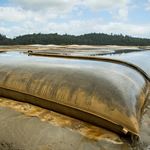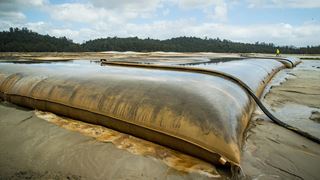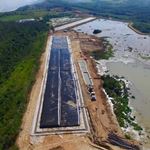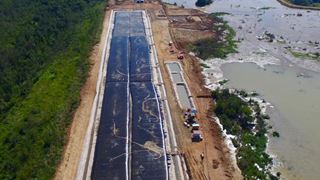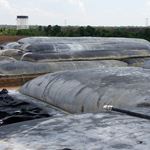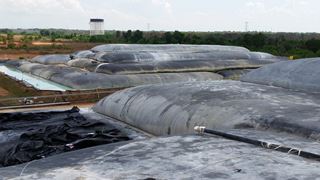Case story
The Recovery of Consolidated Mineral Rich Solids in Gold Mining with Geotube® Dewatering Technology
Indonesia
The challenge
A gold mine located on a remote island of Indonesia required heavily silted settling ponds to be dredged. The sediment in the ponds contained valuable gold deposits worth recovering and re-processing.The lack of free land space is often a problem. To avoid incurring high costs and the challenges of building new ponds, the settlement ponds that are filled with mineral rich slurry can be dewatered to enable the recovery of solids to be reprocessed.
Calculations and tests
Having run the calculations of using TenCate Geotube® dewatering units to contain and dewater the mineral rich slurry, the value of the minerals recovered would be able to partially offset the cost of desilting the ponds. This would overall be a more cost effective and time efficient alternative to constructing new ponds.
In any dewatering project, it is necessary to define the final solids dryness. To do so, TenCate Geosynthetics developed two dewatering tests:
The first is the Rapid Dewatering Test (RDT) which determines how well a representative sample of slurry dewaters. It also ascertains the optimum type and percentage of flocculant required to aid the dewatering process. The test indicates the mass of solids remaining after the liquid portion is discharged through the Geotube® fabric.
The second is the Geotube® Dewatering Test (GDT) which involves the use of a small pillow bag to visualize the dewatering process, the clarity of the effluent, and to predict the achievable percentage of solids. This test typically uses between 15 - 20 liters of a representative sample of slurry.
Geotube® design and operation
Once the nature of the slurry has been defined and the volume of slurry to be dewatered is ascertained, the optimum Geotube® unit sizes are calculated.
The tests on the slurry from this project indicated a weighted average solids mass concentration of the sludge to be between 10% to 15%, and a dewatered solids concentration of between 55% to 65%. This can be achieved with 4 to 6 filling and dewatering cycles. It was determined that Geotube® units comprising GT500D fabric with a circumference of 13.7 m and length of 30.6 m would be most appropriate as they best fitted the space available for construction of the dewatering pad and the total volume of slurry to be dewatered.
During the pumping process, the slurry was injected with polymer flocculant just before discharging into the Geotube® units. The flocculant mixes into the slurry by passing through a simple pipe mixer. The pump rate was 80 m³ per hour. Effluent discharged from the Geotube® units was collected in a sump and discharged back into the adjacent ponds.
The performance
This project illustrates the functionality and versatility of TenCate Geotube® dewatering technology in recovering mineral rich slurry pond residue for re-processing. The benefits of high-volume reduction and high solids concentration enabled greater value to be derived from the recovery of minerals which was used to offset the cost of desilting the ponds. With Geotube ® Dewatering, the need for constructing additional settlement ponds and land purchase was eliminated.
Further information on this and other large scale Geotube® dewatering projects can be obtained by contacting us.
Dewatered gold slurry extracted for reprocessing to recover residual mineral content
Samples taken from the sample port showing typical discharge clarity achieved
Typical example of the polymer make-down unit (PMU) used to mix flocculant prior to slurry being discharged into the Geotube® units
Dredger units used to dewater the slurry in the pond
Deploying the Geotube® units on the dewatering pad
Site operation
Slitting the dewatered tube to recover solids for re-processing
Dry cake derived prior to reprocessing



